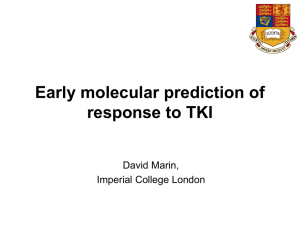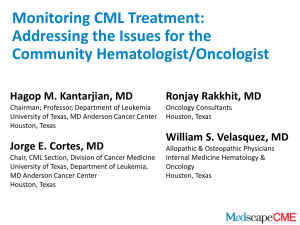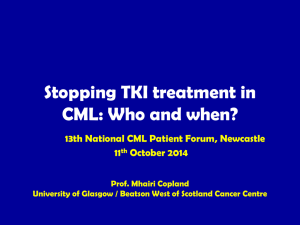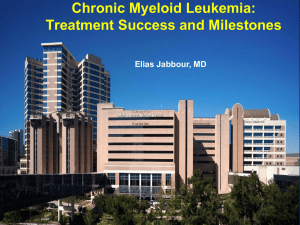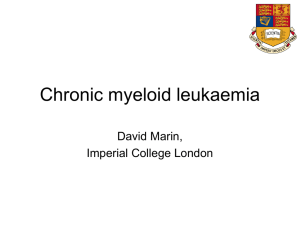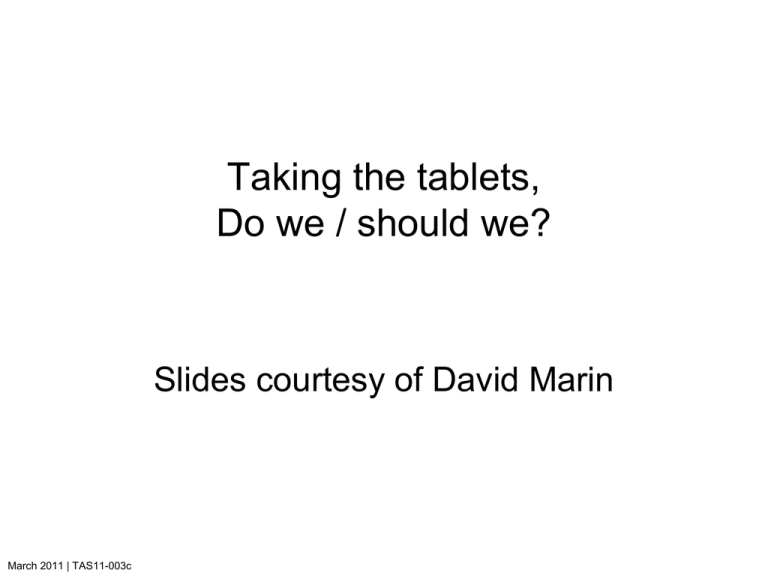
Taking the tablets,
Do we / should we?
Slides courtesy of David Marin
March 2011 | TAS11-003c
• It’s one thing to take a tablet over a short
period
• It’s another thing to take it for life
March 2011 | TAS11-003c
There is a great variability in the
response to imatinib. I wonder why
BCR-ABL/ABL ratio (%)
100
10
CCyR
1
3 log
0.1
0.01
0.001
0.0001
Time from start of imatinib
March 2011 | TAS11-003c
Slide courtesy of Dr David Marin
Study design
BCR/ABL/ABL ratio (%)
100
Imatinib
plasma
level
10
1
MEMS
0.1
0.01
0.001
TKD
mutations
Time from start of imatinib
• hOCT1 level
• MDR-1 polymorphisms
• BCR-ABL transcript type
• BCR-ABL transcript level
• Sokal score
• Haemoglobin
• White blood cell count
• Sex
• Age
March 2011 | TAS11-003c
We correlated all these variables with the
molecular response achieved by the patient
Marin D et al. J Clin Oncol 2010; 28(14): 2381–2388.
Slide courtesy of Dr David Marin
Microelectronic Monitoring System
(MEMS 6 Trackcap)
• Records the time of opening
the container
• Most reliable method of
measuring adherence
• Our patients: not told about
the chip
March 2011 | TAS11-003c
Slide courtesy of Dr David Marin
March 2011 | TAS11-003c
Slide courtesy of Dr David Marin
Long-term adherence to imatinib
100
Proportion of patients (%)
90
80
70
60
50
40.2%
40
30
20
25.3%
13.8%
10
0
<80%
12.6%
8%
80–90% 90–95% 95–99% ≥100%
Percentage of intended dose
March 2011 | TAS11-003c
Marin D et al. J Clin Oncol 2010; 28(14): 2381–2388.
Slide courtesy of Dr David Marin
Lack of adherence
is underestimated by conventional methods
Proportion of patients (%)
100
90
80
70
60
Self reporting
Pill count
MEMS
50
40
30
20
10
0
<80% 80–90% 90–95% 95–99% ≥100%
Percentage of intended dose
March 2011 | TAS11-003c
Marin D et al. J Clin Oncol 2010; 28(14): 2381–2388.
Slide courtesy of Dr David Marin
Unintentional non-adherence
13/21 patients
“And sometimes you just
forget. It’s very strange.
It’s almost a surprise
when you don’t take it”
“They [the pharmacy] had
no medication for me, so I
went for nearly a week with
no medication.”
March 2011 | TAS11-003c
Slide courtesy of Dr David Marin
Intentional non-adherence 10/21
patients
“Oh I can’t be bothered
tonight, it’s not going to kill
me [to miss a dose] – sort
of thing, so I just go to
sleep”
“I thought there was no way I was
going [on holiday] and being tired.
So I did actually stop taking the
tablets for a week before I went, and
I didn’t take them for the first half of
the week I was there”
March 2011 | TAS11-003c
Slide courtesy of Dr David Marin
12/21 patients said:
“The odd missed dose doesn’t matter”
“I suppose, I’m not a doctor, but I
don’t think missing one pill, or 3
pills, in a month affects me at all”
“So I don’t feel I am putting
myself in any danger by
not taking an odd dose
now and again”
March 2011 | TAS11-003c
Slide courtesy of Dr David Marin
Reasons for poor adherence
Theme
Sub-theme
1.1 Unintentional
non-adherence
Forgetting
Accidentally taking too much
Prescribing error
No imatinib availability at pharmacy
Frequency of unintentional non-adherence
1.2 Intentional
non-adherence
Because of side effects
Because of socialising / dining out / drinking alcohol
Because of travelling
Because of diversion from planned activities
Because of temporary illness (bug / cold)
Because of risk of pregnancy
Because of side negative emotions & feelings
Because of “no real reason / lack of discipline”
Changed doses
Frequency intentional
Contemplating future non-adherence
March 2011 | TAS11-003c
Slide courtesy of Dr David Marin
6-year probability of MMR according to
the measured adherence rate
P<0.001
Marin D et al. J Clin Oncol 2010; 28(14): 2381–2388.
March 2011 | TAS11-003c
Slide courtesy of Dr David Marin
6-year probability of CMR according to
the measured adherence rate
P=0.002
Marin D et al. J Clin Oncol 2010; 28(14): 2381–2388.
March 2011 | TAS11-003c
Slide courtesy of Dr David Marin
Other variables are also predictive for the
achievement of molecular response
Variables
n
MMR (%)
4-log (%)
CMR (%)
40
47
P=0.036
59.2
80.7
1.186, P=0.012
P=0.03
39.5
69.1
1.323, P=0.01
P=0.011
14.7
47.6
1.209, P=0.07
Leukocytes
≤140 x 109/l
>140 x 109/l
RR
44
43
P=0.012
78.8
63.1
0.996, P=0.008
P=0.022
56.7
37.6
0.996, P=0.015
P=0.17
35.4
28.1
0.996, P=0.11
BCR-ABL1/ABL1 ratio
≤100%
>100%
RR
44
43
P=0.25
71.4
52.6
0.996, P=0.44
P=0.038
53.0
26.6
0.971, P=0.002
P=0.1
32.7
8.4
0.979, P=0.13
hOCT1 transcript level
≤0.16
>0.16
RR
30
30
P<0.001
55.2
81.4
2.199, P<0.001
P=0.01
42.0
64.8
1.990, P=0.001
P=0.02
16.6
45.3
1.665, P=0.04
Imatinib plasma level
≤1 g/ml
>1 g/ml
RR
43
41
P=0.02
60.1
83.2
2.11, P=0.01
P=0.07
53.0
68.0
2.50, P=0.06
P=0.14
23.3
44.4
2.25, P=0.09
64
23
P<0.001
93.7
13.9
1.093, P<0.001
P<0.001
76.0
4.3
1.104, P=0.002
P=0.002
43.8
0
RR= 1.135, P=0.012
Haemoglobin
≤115 g/l
>115 g/l
RR
Adherence rate
>90%
≤90%
RR
Marin D et al. J Clin Oncol 2010; 28(14): 2381–2388.
March 2011 | TAS11-003c
Slide courtesy of Dr David Marin
The level of hOCT1 measured at diagnosis
is predictive for achievement of molecular response
1.0
CMR
Cumulative incidence of CMR
incidence of CMR
Cumulative
Cumulativeincidence
incidence of MMR
of MMR
Cumulative
MMR
p<0.001
p=0.0003
P<0.001
0.9
hOCT1
0.8
0.7
0.6
0.5
hOCT1
0.4
0.3
0.2
0.1
0.0
0
6
12
Months
18
24
30
36
42
48
54
60
66
72
Months
startof
of imatinib
therapy
from from
start
imatinib
therapy
1.0
P=0.02
p=0.02
0.9
0.8
0.7
0.6
hOCT1
0.5
0.4
0.3
0.2
hOCT1
0.1
0.0
0
6
12
18
24
30
36
42
48
54
60
66
72
Months from start of imatinib therapy
Months from start of imatinib therapy
hOCT1=human organic cation transporter 1
March 2011 | TAS11-003c
Slide courtesy of Dr David Marin
But adherence to therapy is the critical factor for
achieving molecular response
• MMR
– Adherence to imatinib therapy, RR=11.17 (P=0.001)
– hOCT1 transcript level, RR=1.79 (P=0.038)
• CMR
– Adherence to imatinib therapy, RR=19.35 (P=0.004)
RR: relative risk
March 2011 | TAS11-003c
Marin D et al. J Clin Oncol 2010; 28(14): 2381–2388.
Slide courtesy of Dr David Marin
Imatinib plasma levels are not an independent
predictor of molecular response
P=0.003
P=0.68
Total population
Adherent patients
Marin D et al. J Clin Oncol 2010; 28(14): 2381–2388.
March 2011 | TAS11-003c
Slide courtesy of Dr David Marin
Study design
BCR/ABL/ABL ratio (%)
100
10
1
MEMS
0.1
0.01
0.001
Time from start of imatinib
• hOCT1 level
• MDR-1 polymorphisms
• BCR-ABL transcript type
• BCR-ABL transcript level
• Sokal score
• Haemoglobin
• White blood cell count
• Sex
• Age
March 2011 | TAS11-003c
We correlated all these variables with the
molecular response achieved by the patient
Marin D et al. J Clin Oncol 2010; 28(14): 2381–2388.
Slide courtesy of Dr David Marin
Poor adherent patients have a higher probability of
losing the CCyR and a lower EFS
1.0
P<0.0001
p<0.0001
0.9
0.9
0.8
0.8
Probability of imatinib failure
Cumulate incidence of loss of CCyR
1.0
Adherence rate ≤85%, n=18
0.7
Adherence rate >85%, n=69
0.6
0.5
0.4
0.3
0.7
p<0.0001
P<0.0001
0.6
0.5
0.4
0.3
0.2
0.2
Adherence rate ≤85%, n=18
0.1
0.1
Adherence rate >85%, n=69
0.0
0.0
0
March 2011 | TAS11-003c
6
12
Months from enrolment
18
24
0
6
12
Months from enrolment
18
24
Slide courtesy of Dr David Marin
Probability of loss of CCyR according
to the level of molecular response
1.0
CCyR
no MMR,
n= 92 n=92
CCyrwith
with
no MMR,
0.9
0.8
CCyR
with
MMR,
n= 32 n=32
CCyR
with
MMR,
0.8
0.7
P=0.04
p=
0.04
0.6
0.5
0.4
0.3
23.9%
0.2
Probability of loss of CCyR
Probability of loss of CCyR
1.0
12 months
0.9
18 months
CCyR with
nono
MMR,
n=91 n=91
CCyr
with
MMR,
CCyR with
MMR,
n= 41n=41
CCyR
with
MMR,
P=0.04
p= 0.006
0.7
0.6
0.5
0.4
24.6%
0.3
0.2
0.1
2.6%
0.0
0.1
0%
0.0
0
6
12
18
24
30
36
42
48
Months from starting imatinib therapy
54
60
0
6
12
18
24
30
36
42
48
54
60
Months from starting imatinib therapy
Marin D et al. Blood 2008; 112(12): 4437–4444.
March 2011 | TAS11-003c
Slide courtesy of Dr David Marin
On multivariate analysis, the adherence
rate and having failed to achieve a major
molecular response are the only
independent predictors for loss of CCyR
and discontinuation of imatinib therapy.
March 2011 | TAS11-003c
Slide courtesy of Dr David Marin
Adherence and the achievement of MMR are the
only independent predictors for outcome
1.0
1.0
P<0.0001
p<0.0001
0.9
MMR, n=53
0.8
Probability of imatinib failure
Cumulate incidence of loss of CCyR
0.9
CCyR, no MMR, Adherence Rate ≤85%, n=11
0.7
CCyR, no MMR, Adherence Rate >85%, n=23
0.6
0.5
0.4
0.3
p<0.0001
P<0.0001
0.2
p=0.0009
P=0.0009
0.7
0.5
0.4
0.3
0.0
0.0
March 2011 | TAS11-003c
12
Months from enrolment
18
24
MMR, n=53
0.2
0.1
6
p<0.0001
P<0.0003
P<0.0001
0.6
0.1
0
p=0.003
P=0.003
0.8
CCyR, no MMR, Adherence Rate ≤85%, n=11
CCyR, no MMR, Adherence Rate >85%, n=23
0
6
12
18
24
Months from enrolment
Slide courtesy of Dr David Marin
Conclusions
• A significant proportion of patients fail to take the
prescribed dose of imatinib
• Adherence to therapy is the critical factor for optimal
response
• Poor adherence is the main reason for imatinib failure in
patient on long term therapy
• Intentional and unintentional reasons for non-adherence
• Poor understanding of consequences
March 2011 | TAS11-003c
Slide courtesy of Dr David Marin


